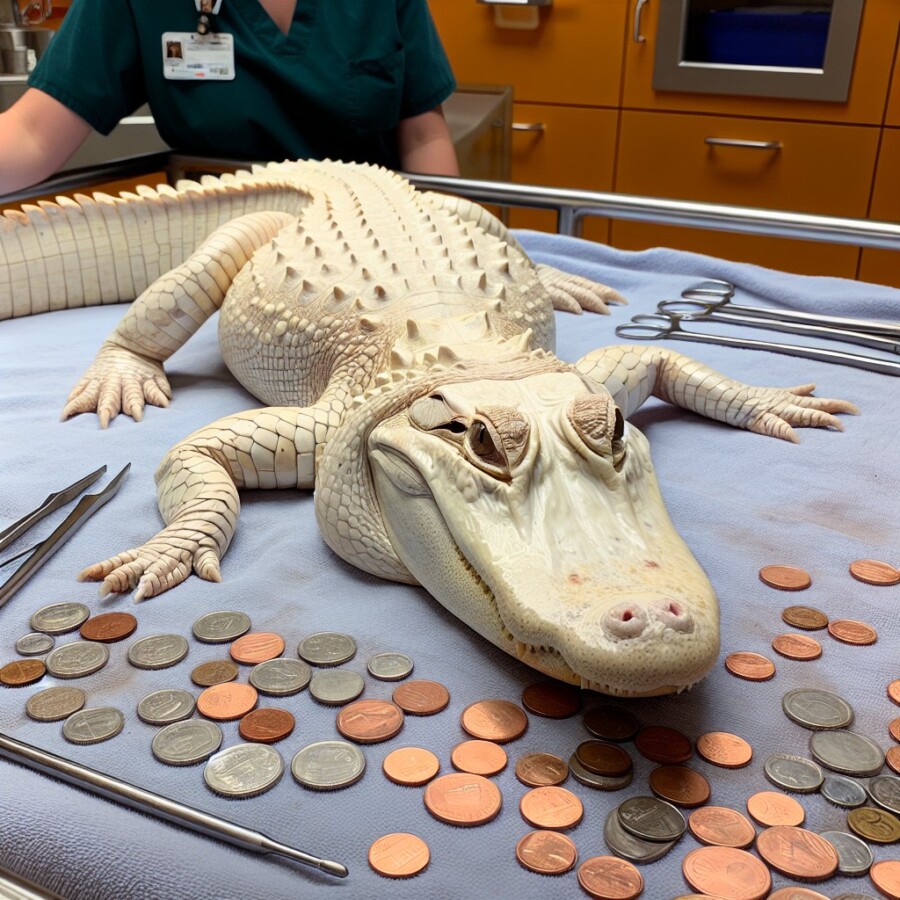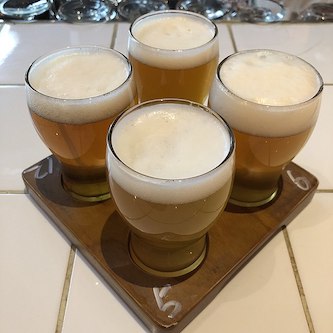A special white alligator at a zoo in Nebraska had to have an operation to take out 70 coins from its tummy. The alligator, named Thibodaux, is 36 years old and has a rare condition that makes it have white skin and blue eyes. People who visited the zoo threw coins into the alligator’s home and it ate them over time. The zoo wants people to stop throwing coins into any water at the zoo. Thibodaux is all better now and back in its home.
The zoo checked all 10 alligators, including Thibodaux, to make sure they were healthy. They took blood and X-ray pictures. When they found the coins, they acted fast and did surgery to take them out before the alligator got hurt. The surgery was done by a vet named Christina Ploog. She used a plastic pipe to protect the alligator’s mouth and get the coins out safely.
The zoo wants everyone to know that this kind of surgery doesn’t happen a lot. They also want people to understand that coins can be dangerous for animals. Coins might have bad stuff in them that can hurt animals. The zoo cleans the alligators’ homes often, but the alligators still find and eat the coins before they can be taken away.
This shows how important it is to be careful about what we throw into animal homes. Even things that seem harmless, like coins, can be bad for animals. The zoo did a good job with Thibodaux’s surgery, and it reminds us to be respectful to animals and their homes by not throwing things into their homes.
Original news source: US zoo extracts 70 coins from white alligator (BBC)
🎧 Listen:
Slow
Normal
Fast
📖 Vocabulary:
| 1 | operation | A medical procedure to fix or remove something from the body |
| 2 | rare | Not common or usual; very unusual |
| 3 | visitors | People who come to see a place, especially for leisure |
| 4 | consumed | Ate or drank something |
| 5 | surgery | A medical procedure performed by doctors or specialists to fix health issues |
| 6 | vet | A doctor for animals |
| 7 | protective | Meant to keep someone or something safe from harm |
| 8 | harmful | Likely to cause damage or injury |
| 9 | cleans | Makes something free of dirt, marks, or mess |
| 10 | respectful | Showing consideration, politeness, and good manners towards others |
| 11 | homes | Places where creatures live, sleep, and spend their time |
| 12 | reminds | Causes someone to remember or think about something |
| 13 | condition | A particular state of being or health |
| 14 | dangerous | Likely to cause harm or injury |
| 15 | respectful | Showing consideration, politeness, and good manners towards others |
Group or Classroom Activities
Warm-up Activities:
– News Summary
Instructions:
1. Divide the class into pairs or small groups.
2. Provide each group with a copy of the article.
3. Explain that each group will have a set amount of time (e.g. 10 minutes) to read the article and summarize the main points.
4. After the time is up, each group will take turns presenting their summaries to the class.
5. Encourage the other groups to ask questions or add any additional information they remember from the article.
– Opinion Poll
Instructions:
1. Divide the class into pairs or small groups.
2. Explain that each group will be conducting an opinion poll about the article.
3. Give each group a list of questions related to the article (e.g. “Do you think people should be allowed to throw coins into animal homes?” “Should the zoo do more to prevent visitors from throwing coins?”)
4. In their groups, students should take turns asking and answering the questions and recording their group members’ opinions.
5. After completing the poll, each group will share their findings with the class, summarizing the different opinions they gathered.
– Vocabulary Pictionary
Instructions:
1. Write a list of vocabulary words from the article on the board (e.g. alligator, surgery, coins, zoo).
2. Divide the class into pairs or small groups.
3. Explain that each group will take turns selecting a word from the list and drawing a quick sketch to represent the word.
4. The other group members must guess the word based on the sketch within a set amount of time (e.g. 1 minute).
5. After each round, rotate the group members so everyone gets a chance to draw and guess.
– Synonym Challenge
Instructions:
1. Write a list of key words from the article on the board (e.g. operation, condition, coins, surgery).
2. Divide the class into pairs or small groups.
3. Explain that each group will have a set amount of time (e.g. 5 minutes) to come up with as many synonyms for the words on the list as possible.
4. After the time is up, each group will take turns sharing their synonyms with the class.
5. Encourage the class to discuss any differences in meaning or usage between the synonyms.
– Sketch It
Instructions:
1. Divide the class into pairs or small groups.
2. Provide each group with a blank sheet of paper.
3. Explain that each group will have a set amount of time (e.g. 5 minutes) to sketch a scene from the article.
4. After the time is up, each group will take turns presenting their sketches to the class, explaining which part of the article their sketch represents.
5. Encourage the class to ask questions and discuss the different interpretations of the article through the sketches.
🤔 Comprehension Questions:
1. What was the special condition that the white alligator named Thibodaux had?
2. Why did Thibodaux have to have an operation?
3. Why did people throw coins into Thibodaux’s home?
4. What did the zoo do to make sure all the alligators were healthy?
5. Who performed the surgery on Thibodaux?
6. Why does the zoo want people to stop throwing coins into any water at the zoo?
7. Why is it important to be careful about what we throw into animal homes?
8. What does Thibodaux’s surgery remind us to do?
Go to answers ⇩
🎧✍️ Listen and Fill in the Gaps:
A special white alligator at a zoo in (1)______ had to have an operation to take out 70 coins from its tummy. The alligator, named Thibodaux, is 36 years old and has a rare condition that makes it have white skin and blue eyes. (2)______ who (3)______ the zoo threw coins into the alligator’s home and it ate them over time. The zoo wants (4)______ to stop throwing coins into any (5)______ at the zoo. Thibodaux is all better now and back in its home.
The zoo checked all 10 alligators, (6)______ Thibodaux, to make sure they were healthy. They took blood and X-ray pictures. When they found the coins, they acted fast and did (7)______ to take them out before the alligator got hurt. The surgery was done by a vet named Christina (8)______. She used a plastic pipe to protect the alligator’s mouth and get the coins out safely.
The zoo wants everyone to know that this kind of surgery doesn’t happen a lot. They also want people to understand that coins can be (9)______ for animals. Coins might have bad (10)______ in them that can hurt animals. The zoo (11)______ the alligators’ (12)______ often, but the alligators still find and eat the coins before they can be taken away.
This shows how important it is to be careful about what we throw into animal homes. Even things that seem (13)______, like coins, can be bad for (14)______. The zoo did a good job with Thibodaux’s surgery, and it (15)______ us to be respectful to animals and their homes by not (16)______ things into their homes.
Go to answers ⇩
💬 Discussion Questions:
Students can ask a partner these questions, or discuss them as a group.
1. What is a special white alligator?
2. How do you think Thibodaux felt when it had to have an operation?
3. Have you ever visited a zoo? What did you see there?
4. Do you like alligators? Why or why not?
5. How would you feel if people threw coins into your home?
6. Do you think it’s important to be careful about what we throw into animal homes? Why or why not?
7. Have you ever seen a rare animal before? What was it like?
8. Do you think the zoo did the right thing by checking all the alligators’ health? Why or why not?
9. What do you think the vet used to protect the alligator’s mouth during the surgery?
10. How would you feel if you found out that coins can be dangerous for animals?
11. Do you think people should be respectful to animals and their homes? Why or why not?
12. Have you ever thrown something into an animal’s home by accident? What happened?
13. What do you think the zoo could do to prevent people from throwing coins into the alligators’ home?
14. How would you feel if you were an alligator living in a zoo?
15. Do you think the zoo should have a rule against throwing things into animal homes? Why or why not?
Individual Activities
📖💭 Vocabulary Meanings:
Match each word to its meaning.
Words:
1. operation
2. rare
3. visitors
4. consumed
5. surgery
6. vet
7. protective
8. harmful
9. cleans
10. respectful
11. homes
12. reminds
13. condition
14. dangerous
15. respectful
Meanings:
(A) A doctor for animals
(B) Likely to cause damage or injury
(C) Places where creatures live, sleep, and spend their time
(D) Showing consideration, politeness, and good manners towards others
(E) A particular state of being or health
(F) Ate or drank something
(G) Likely to cause harm or injury
(H) Meant to keep someone or something safe from harm
(I) People who come to see a place, especially for leisure
(J) Causes someone to remember or think about something
(K) Showing consideration, politeness, and good manners towards others
(L) Makes something free of dirt, marks, or mess
(M) Not common or usual; very unusual
(N) A medical procedure performed by doctors or specialists to fix health issues
(O) A medical procedure to fix or remove something from the body
Go to answers ⇩
🔡 Multiple Choice Questions:
1. Why did Thibodaux the alligator have to have an operation?
(a) It had a rare condition
(b) It ate 70 coins
(c) It was 36 years old
(d) It had white skin and blue eyes
2. What did people throw into Thibodaux’s home at the zoo?
(a) Food
(b) Toys
(c) Flowers
(d) Coins
3. What did the zoo do to make sure all the alligators were healthy?
(a) Gave them medicine
(b) Gave them new homes
(c) Gave them more food
(d) Checked their blood and took X-ray pictures
4. Who performed the surgery on Thibodaux?
(a) The zookeeper
(b) Thibodaux himself
(c) Christina Ploog
(d) Another alligator
5. Why does the zoo want people to stop throwing coins into water at the zoo?
(a) Coins are expensive
(b) Coins can be dangerous for animals
(c) The zoo doesn’t like coins
(d) The water gets dirty with coins
6. What did the zoo use to protect Thibodaux’s mouth during surgery?
(a) A plastic pipe
(b) A metal rod
(c) A wooden stick
(d) A cloth
7. What does the article say about coins and animals?
(a) Coins can have bad stuff in them that can hurt animals
(b) Coins are fun for animals to play with
(c) Coins are good for animals’ health
(d) Coins are not interesting to animals
8. What does the article remind us to do?
(a) Throw things into animal homes
(b) Visit the zoo more often
(c) Be respectful to animals and their homes
(d) Give coins to alligators
Go to answers ⇩
🕵️ True or False Questions:
1. The zoo wants to raise awareness about the dangers of coins for animals and emphasizes the importance of respecting animals and their habitats by not throwing objects into their enclosures.
2. The zoo is urging people to stop throwing coins into any water at the zoo.
3. A vet named Christina Ploog conducted the operation, utilizing a plastic tube to safeguard Thibodaux’s mouth during the process.
4. A white alligator called Thibodaux in a Nebraska zoo recently underwent surgery to extract 70 coins from its stomach.
5. The zoo conducted health checks on all 10 alligators, including Thibodaux, to ensure their well-being.
6. Blood tests and X-rays were taken to locate the coins in Thibodaux’s stomach.
7. Thibodaux is a unique alligator with albino skin and blue eyes because of a rare condition.
8. Visitors to the zoo tossed coins into Thibodaux’s exhibit, causing it to consume them eventually.
Go to answers ⇩
📝 Write a Summary:
Write a summary of this news article in two sentences.
Check your writing now with the best free AI for English writing!
Writing Questions:
Answer the following questions. Write as much as you can for each answer.
Check your answers with our free English writing assistant!
1. What was the rare condition that the special white alligator, Thibodaux, had?
2. Why did people throw coins into Thibodaux’s home at the zoo?
3. How did the zoo check to make sure all the alligators were healthy?
4. What did the vet, Christina Ploog, use to protect Thibodaux’s mouth during the surgery?
5. Why does the zoo want people to be careful about what they throw into animal homes?
✅ Answers
🤔✅ Comprehension Question Answers:
1. What was the special condition that the white alligator named Thibodaux had?
Thibodaux had a rare condition that made it have white skin and blue eyes.
2. Why did Thibodaux have to have an operation?
Thibodaux had to have an operation because it had eaten 70 coins that people threw into its home at the zoo.
3. Why did people throw coins into Thibodaux’s home?
People threw coins into Thibodaux’s home as a way of making a wish or for good luck.
4. What did the zoo do to make sure all the alligators were healthy?
The zoo checked all the alligators, including Thibodaux, by taking blood and X-ray pictures to make sure they were healthy.
5. Who performed the surgery on Thibodaux?
The surgery on Thibodaux was performed by a vet named Christina Ploog.
6. Why does the zoo want people to stop throwing coins into any water at the zoo?
The zoo wants people to stop throwing coins into any water at the zoo because coins can be dangerous for animals and might have harmful substances in them.
7. Why is it important to be careful about what we throw into animal homes?
It is important to be careful about what we throw into animal homes because even seemingly harmless things like coins can be harmful to animals and their health.
8. What does Thibodaux’s surgery remind us to do?
Thibodaux’s surgery reminds us to be respectful to animals and their homes by not throwing things into their habitats.
Go back to questions ⇧
🎧✍️✅ Listen and Fill in the Gaps Answers:
(1) Nebraska
(2) People
(3) visited
(4) people
(5) water
(6) including
(7) surgery
(8) Ploog
(9) dangerous
(10) stuff
(11) cleans
(12) homes
(13) harmless
(14) animals
(15) reminds
(16) throwing
Go back to questions ⇧
📖💭✅ Vocabulary Meanings Answers:
1. operation
Answer: (O) A medical procedure to fix or remove something from the body
2. rare
Answer: (M) Not common or usual; very unusual
3. visitors
Answer: (I) People who come to see a place, especially for leisure
4. consumed
Answer: (F) Ate or drank something
5. surgery
Answer: (N) A medical procedure performed by doctors or specialists to fix health issues
6. vet
Answer: (A) A doctor for animals
7. protective
Answer: (H) Meant to keep someone or something safe from harm
8. harmful
Answer: (B) Likely to cause damage or injury
9. cleans
Answer: (L) Makes something free of dirt, marks, or mess
10. respectful
Answer: (D) Showing consideration, politeness, and good manners towards others
11. homes
Answer: (C) Places where creatures live, sleep, and spend their time
12. reminds
Answer: (J) Causes someone to remember or think about something
13. condition
Answer: (E) A particular state of being or health
14. dangerous
Answer: (G) Likely to cause harm or injury
15. respectful
Answer: (D) Showing consideration, politeness, and good manners towards others
Go back to questions ⇧
🔡✅ Multiple Choice Answers:
1. Why did Thibodaux the alligator have to have an operation?
Answer: (b) It ate 70 coins
2. What did people throw into Thibodaux’s home at the zoo?
Answer: (d) Coins
3. What did the zoo do to make sure all the alligators were healthy?
Answer: (d) Checked their blood and took X-ray pictures
4. Who performed the surgery on Thibodaux?
Answer: (c) Christina Ploog
5. Why does the zoo want people to stop throwing coins into water at the zoo?
Answer: (b) Coins can be dangerous for animals
6. What did the zoo use to protect Thibodaux’s mouth during surgery?
Answer: (a) A plastic pipe
7. What does the article say about coins and animals?
Answer: (a) Coins can have bad stuff in them that can hurt animals
8. What does the article remind us to do?
Answer: (c) Be respectful to animals and their homes
Go back to questions ⇧
🕵️✅ True or False Answers:
1. The zoo wants to raise awareness about the dangers of coins for animals and emphasizes the importance of respecting animals and their habitats by not throwing objects into their enclosures. (Answer: True)
2. The zoo is urging people to stop throwing coins into any water at the zoo. (Answer: True)
3. A vet named Christina Ploog conducted the operation, utilizing a plastic tube to safeguard Thibodaux’s mouth during the process. (Answer: False)
4. A white alligator called Thibodaux in a Nebraska zoo recently underwent surgery to extract 70 coins from its stomach. (Answer: False)
5. The zoo conducted health checks on all 10 alligators, including Thibodaux, to ensure their well-being. (Answer: True)
6. Blood tests and X-rays were taken to locate the coins in Thibodaux’s stomach. (Answer: True)
7. Thibodaux is a unique alligator with albino skin and blue eyes because of a rare condition. (Answer: False)
8. Visitors to the zoo tossed coins into Thibodaux’s exhibit, causing it to consume them eventually. (Answer: False)
Go back to questions ⇧













